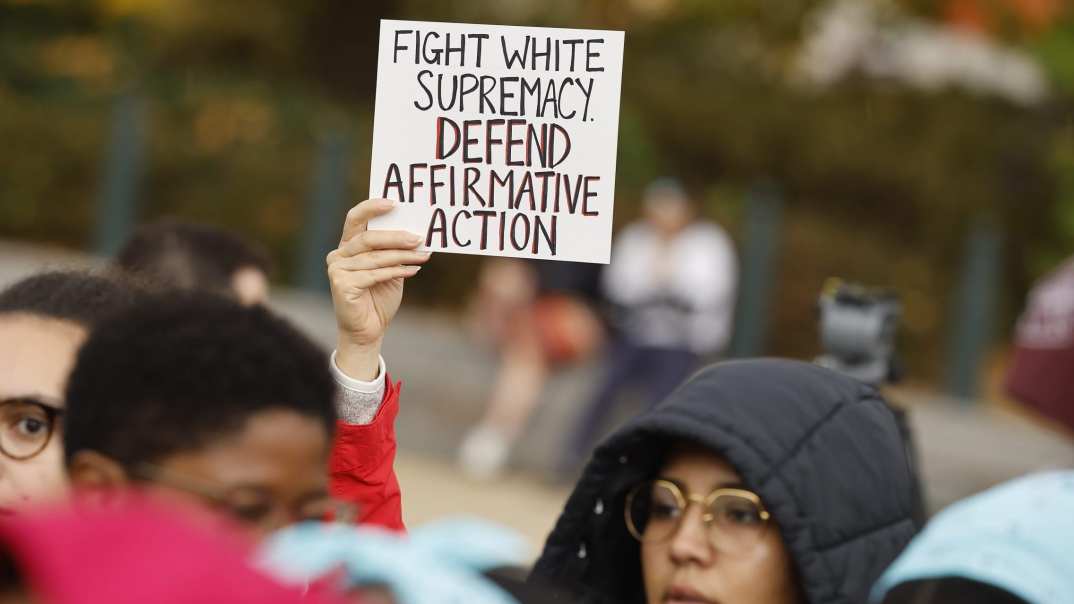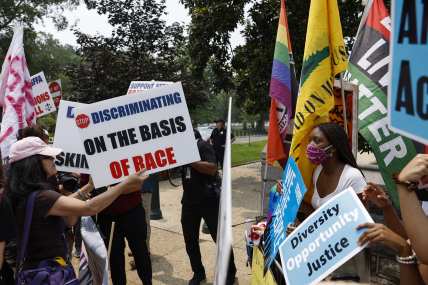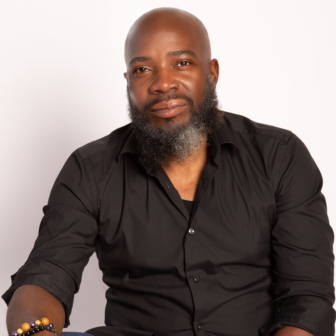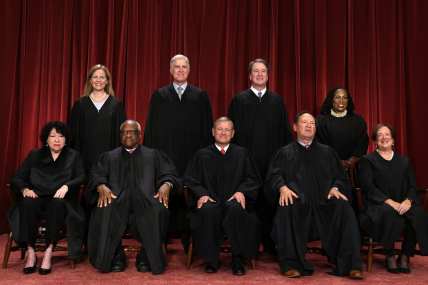Take things from white people
OPINION: Perhaps the best way to counter the opposition to affirmative action, reparations and every Black movement for justice and equality is to culturally appropriate America's tradition of state-sponsored strong-arming.

Editor’s note: The following article is an op-ed, and the views expressed are the author’s own. Read more opinions on theGrio.
What is the opposite of backlash?
On Friday, Tulsa County Oklahoma District Court judge Caroline Wall dismissed the lawsuit filed by survivors of the Tulsa Race Massacre seeking compensatory justice for the 1921 destruction of the once-thriving Black business district known as Greenwood. The dismissal follows the Supreme Court decision that effectively erased race-based considerations in college admissions. Over the last five years, the long game of white supremacy has stymied police reform, thwarted student debt relief, criminalized Black history, ousted Black educators attempting to equalize education and made it harder for Black people to cast ballots.
Perhaps nothing is as reliable as the metronomic predictability of white people’s reaction to even the prospect of racial progress. However, a careful examination of America’s past shows us that “backlash” is an ineffective descriptor for the racial hostility defined by these setbacks. The slash-and-burn racial animus that gave us separate but equal, Jim Crow, countless massacres, unequal schools and disenfranchisement laws is not a reaction to anything that Black people achieved.
Most white Americans (57%) disapprove of selective colleges considering race and ethnicity in affirmative action. Eighty percent of whites do not support reparations for the descendants of enslaved people, compared to 77% of Black Americans — most of whom descended from enslaved people — who approve. The vast majority of Black, Hispanic and Asian Americans feel more needs to be done to ensure equal rights for all; only 42% of whites agree. In fact, most whites (62%) think our country has done enough or too much to give Black people equal rights. Perhaps it is a “frontlash.” Maybe “prelash” is a better word. “Forwardlash” sounds too benevolent. In any case, these pro-white victories are simply byproducts of the constant, unchanging stream anti-Black sentiment that periodically pierces the wall of Black defenses. And while Black America is furiously defending itself, the white reaction is always the same:
White people come to take things.
Defense vs. Offense
Every movement for Black liberation and equality was about defending ourselves. When Black Americans unchained themselves from the bonds of race-based slavery, our quest for full citizenship was a measure to defend our humanity. The anti-lynching movement was a defense of our lives. The Civil Rights Movement was a defense of our constitutionally guaranteed human rights. Voting rights protect our participation in democracy. Affirmative action simply prevents further disparities in education and employment.

There’s no such thing as ‘race neutral’
The survivors of the Tulsa Race Massacre were not trying to punish the people of Tulsa, nor were they asking for a handout. They paid taxes to be protected by a law enforcement and justice system that, instead robbed them of their homes, loved ones and livelihoods. The descendants of the enslaved are simply seeking a return on the investment their ancestors contributed to America’s wealth fund. One of the reasons Black students have higher student debt is that banks charge Black students higher interest rates than similarly situated white students.
We play defense because America takes our things.
After the Civil War, whites responded to emancipation with a campaign of racial terrorism and murder that possibly killed more Black people than slavecatchers. We wanted to be free, they wanted our lives. Nonviolent resistance during the civil rights era resulted in beatings, church bombings and resentment even in the liberal North. They didn’t oppose our quest for equality, they opposed us. When Black voters elected Black politicians during Reconstruction, whites didn’t just want to take our voting rights, they killed the people we elected. They were not protecting their power; they wanted to take ours. Black financial gains weren’t met with “economic anxiety,” it was bombed and burned from existence. Segregationists didn’t create massive resistance, segregation academies and decimate the population of Black teachers because they wanted whites-only schools. They spat on our children and bombed them in churches because they wanted Black taxpayers to continue funding their children’s educational advantages. The conservatives who believe affirmative action is anti-white also want to end the Department of Education. Perhaps, instead of defending our rights and fighting for white people to treat us as equals, we should culturally appropriate their proven strategy.
We should take things from white people.
Affirmative action is not what prevents Asians from attending elite unities like Harvard. According to a 2019 study, 43% of white students at Harvard gained admission because they were a legacy, related to a donor, a child of a Harvard employee or an athlete, populations which are overwhelmingly white. When asked, the researchers noted that eliminating these white privilege loopholes would increase the number of African-American, Asian-American and Hispanic students but the white acceptant rate would decrease.
We should take that.
The University of North Carolina, also a plaintiff in the Supreme Court cases that upended affirmative action, is about 8% Black, while the state is 22% Black. Because of the Supreme Court ruling, UNC can no longer consider race as a factor in its admission standards, but it is still free to admit legacies who make up about 17% of the student body. UNC is a state school. Why should African-American taxpayers fund an educational institution that disproportionately excludes them?
Someone should take that from white people.
One of the arguments against Black reparations is that it would cost too much. However, the $10 to $12 trillion in federal expenditures that the leading scholars estimate pales in comparison to the principal and compounding interest on the stolen labor that created the racial wealth gap. It certainly wouldn’t cost white people $800,000 — the difference in the wealth of the average white household compared to a Black household.
We should take that, too.
We should remove their slaveholding heroes from social studies lessons that make Black children feel uncomfortable. We should eliminate job recommendations, unpaid internships and other policies that promote anti-diversity, inequities and exclusion. We should ban white Santas and Christmas songs and pro-police rallies and violent national anthems and cisgender bathrooms and books about heterosexual relationships.
We should not take things from white people out of anger, payback or retribution. It is impossible to recover the blood spilled by white anger and the land stolen by their thievery. But it is an injustice to pretend that not considering race can fix a problem that is real. Justice demands an equal response to the infraction committed. This is just the most logical approach to the history of proactive anti-Blackness.
Thankfully, journalist Wesley Lowery has given us a phrase to describe this undefined phenomenon.
The Whitest Lash
In his new book, “American Whitelash,” the Pulitzer Prize winner examines how the election of Barack Obama “led us down a perilous path and into a decade and a half (and counting) of explicit racial thrashing.” According to Lowery, the combination of white grievances and a long-simmering nativist movement manifested itself in a new era of proactive bigotry.
It is fitting that Lowery chose not to portray this new era of racial resentment as a boomerang effect that emerged in the wake of racial progress. While Obama’s election was remarkable in the context of America’s racist history, it was not a sign of a national leap forward in race relations. The president who preceded him was a mediocre white man endowed with all of the privileges that whiteness can afford. Obama’s immediate successor was a mediocre white man endowed with all of the privileges that whiteness afforded him. Obama was a mere historical anomaly.
Lowery opens his book with a defense of why he decided not to capitalize the two most common racial categories that were concocted, in part, to justify the theft, trafficking and commodification of African labor. “It is currently popular to capitalize the b in black, in acknowledgment of and in reverence for the history, experience, and culture of black Americans,” Lowery writes. “But at this moment in our history — amid pervasive racial violence and destructive white grievance — I fear capitalization provides fodder for those who preach race as a biological reality, as opposed to a societal construction. While racism is deadly real, race itself is a fiction.”
For years, I taught a class called “Race as an Economic Construct.” On the first day of class, I would place a $5 bill and a $100 Monopoly bill at the entrance to the classroom. Inevitably, the first student through the door would pick up the legal tender. The most principled students would ask if anyone dropped a fiver, while no one ever sought out the owner of the Monopoly money. I would use that example to explain that, while social constructs are collectively accepted principles, they are indeed real. U.S. currency is real and it is a social construct. Its worth is based on a collectively agreed valuation; it isn’t backed by gold. In fact, the value of gold is a social construct. It has value because we collectively agree that it does.
Whiteness is real.
The poorest white school districts are better-funded than the wealthiest majority Black districts. Black children. A house in a Black neighborhood is worth $48,000 less than the exact same home in a white neighborhood with similar crime rates, resources and income earners. A poor white child has as much economic opportunity as a Black child raised by wealthy parents. Whiteness is not the only factor that determines one’s future, but whiteness is a more accurate predictor of economic mobility and future success than two-parent homes, education or even parental wealth. In America, whiteness is more valuable than gold or paper plastered with portraits of dead presidents. Those born with it can use it to purchase privileges that are unavailable to those who didn’t inherit America’s most enduring legal tender. It is backed by banking systems and accepted as a form of currency during police stops, real estate transactions and job interviews.
Black people are not real.
Although Black is a color on the light spectrum and a real racial category, Black people are just a figment of white people’s imagination. Blackness is mutable and transferable. Having ancestors from Africa or possessing one-sixteenth of “negro blood” makes a person legally Black unless, of course; they founded a civilization or were pretty or could hit a ball with a stick or became president.
The anti-Black imagination has created a horrific version of Black people that necessitates the taking of things. America’s lynching epidemic was caused by the unreal fear that extrajudicial murder was the only preventative measure white people had against the violent rapists and murderers that they imagined us to be. Segregationists argued that integration would lead to race-mixing and thwart the progress of the superior white intellect. Suppressive voter laws are the result of negroes who cast multiple ballots, vote for dead people and harvest voter registrations to dump into drop boxes. Black-on-white race massacres, the decline of the white IQ and widespread voter fraud are not real. However, the legislation, rules and insurrections that resulted from this fictional version of Black people are real.
“To study white supremacists is to examine a collection of broken people who see their own hardships and traumas as evidence that they are the world’s victims,” Lowery writes. “The movement convinces its followers that their failures and flaws are not the result of their choices or an unlucky spin in the roulette of circumstance, but rather due to a global racial conspiracy far beyond their control.” White people truly believe dead people voted and Black people can get into college because of the color of their skin. It is impossible to convince the average white person that they benefitted from slavery. Even liberal white people believe that America has a class problem and not a race problem. Most believe they don’t have a racist bone in their body. All the facts, history and data will never be able to change their minds. Even trying is a useless pursuit.
We cannot take that away from them.
But, whether they believe it or not, there is a quantifiable, measurable value to whiteness and its accompanying privilege. It is tangible and it is all around us. It cannot be dismantled using preventative measures. Pretending race and racism aren’t real is the most effective way to ensure their continued existence.
Whiteness is a storm that is always brewing. The tidal waves cannot be stopped by plugging our fingers into the walls we have built to protect our rights and our lives. It will always find a way to breach our defenses. And yes, it is as real as the wind. We will never be able to take away their whiteness.
But we can take their lash.

Michael Harriot is a writer, cultural critic and championship-level Spades player. His book, Black AF History: The Unwhitewashed Story of America, will be released in September.
TheGrio is FREE on your TV via Apple TV, Amazon Fire, Roku, and Android TV. Please download theGrio mobile apps today!


